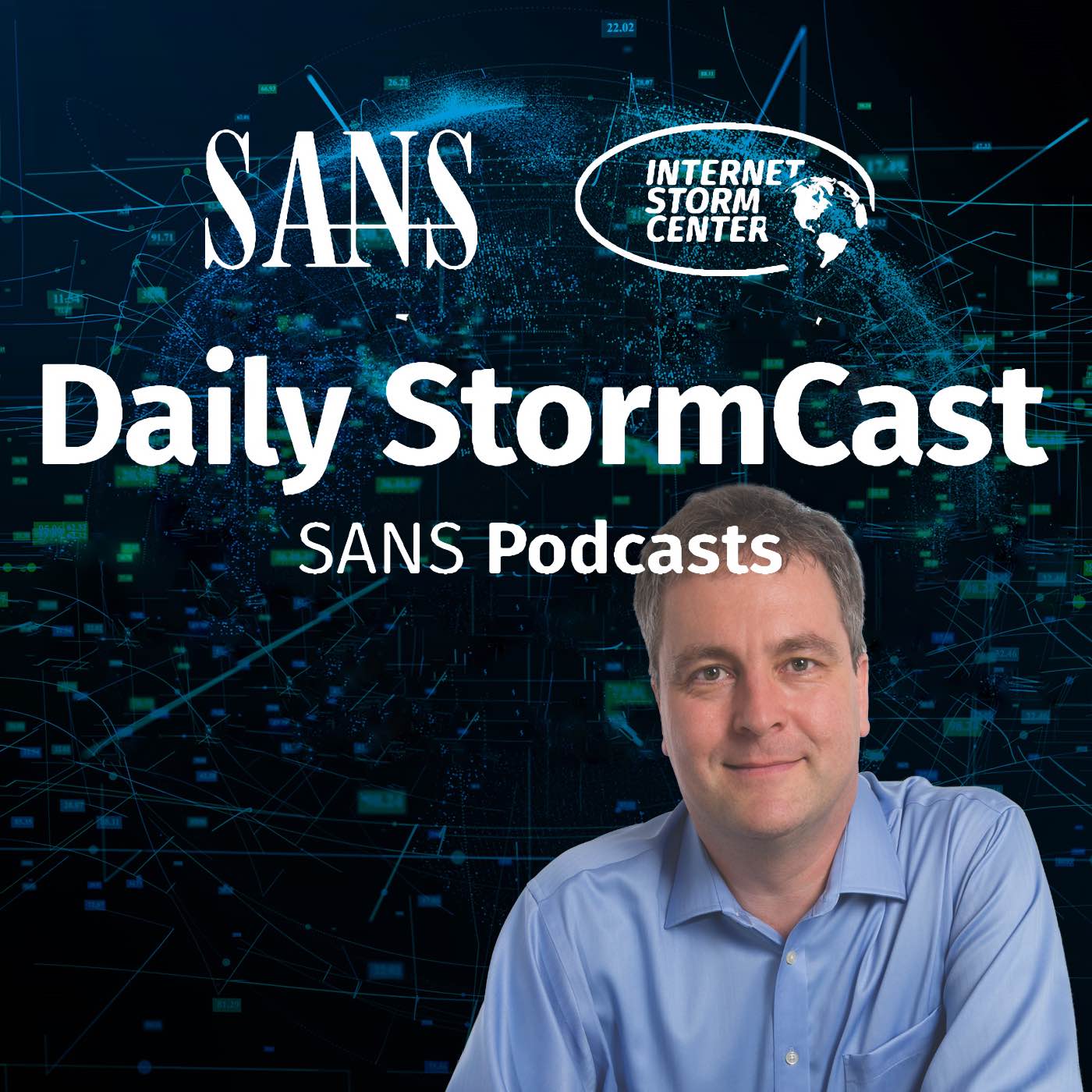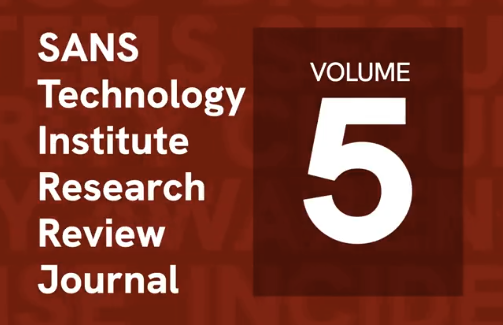Handler on Duty: Xavier Mertens
Threat Level: green
Podcast Detail
SANS ISC Stormcast, Jan 24, 2025: XSS in Email, SonicWall Exploited; Cisco Vulnerablities; AI and SOAR (@sans_edu research paper by Anthony Russo)
If you are not able to play the podcast using the player below: Use this direct link to the audio file: https://traffic.libsyn.com/securitypodcast/9294.mp3

XSS in Email, SonicWall Exploited; Cisco Vulnerablities; AI and SOAR (@sans_edu research paper by Anthony Russo)
00:00
My Next Class
| Network Monitoring and Threat Detection In-Depth | Online | Central European Time | Dec 15th - Dec 20th 2025 |
| Application Security: Securing Web Apps, APIs, and Microservices | Orlando | Mar 29th - Apr 3rd 2026 |
In today's episode, learn how an attacker attempted to exploit webmail XSS vulnerablities against us. Sonicwall released a critical patch fixing an already exploited vulnerability in its SMA 1000 appliance. Cisco fixed vulnerabilities in ClamAV and its Meeting Manager REST API. Learn from SANS.edu student Anthony Russo how to take advantage of AI for SOAR.
XSS Attempts via E-Mail
https://isc.sans.edu/diary/XSS%20Attempts%20via%20E-Mail/31620
An analysis of a recent surge in email-based XSS attack attempts targeting users and organizations. Learn the implications and mitigation techniques.
SonicWall PSIRT Advisory: CVE-2025-23006
https://psirt.global.sonicwall.com/vuln-detail/SNWLID-2025-0002 CVE-2025-23006
Details of a critical vulnerability in SonicWall appliances (SNWLID-2025-0002) and what you need to do to secure your systems.
Cisco ClamAV Advisory: OLE2 Parsing Vulnerability
https://sec.cloudapps.cisco.com/security/center/content/CiscoSecurityAdvisory/cisco-sa-clamav-ole2-H549rphA
A DoS vulnerability in the popular open source anti virus engine ClamAV
Cisco CMM Privilege Escalation Vulnerability
https://sec.cloudapps.cisco.com/security/center/content/CiscoSecurityAdvisory/cisco-sa-cmm-privesc-uy2Vf8pc
A patch of a privilege escalation flaw in Cisco’s CMM module.
Discussion
New Discussions closed for all Podcasts older than two(2) weeks
Please send your comments to our Contact Form
| Network Monitoring and Threat Detection In-Depth | Online | Central European Time | Dec 15th - Dec 20th 2025 |
| Application Security: Securing Web Apps, APIs, and Microservices | Orlando | Mar 29th - Apr 3rd 2026 |
| Network Monitoring and Threat Detection In-Depth | Amsterdam | Apr 20th - Apr 25th 2026 |
| Application Security: Securing Web Apps, APIs, and Microservices | San Diego | May 11th - May 16th 2026 |
| Network Monitoring and Threat Detection In-Depth | Online | Arabian Standard Time | Jun 20th - Jun 25th 2026 |
| Network Monitoring and Threat Detection In-Depth | Riyadh | Jun 20th - Jun 25th 2026 |
| Application Security: Securing Web Apps, APIs, and Microservices | Washington | Jul 13th - Jul 18th 2026 |
Podcast Transcript
Hello and welcome to the Friday, January 24th, 2025 edition of the SANS Internet StormCenters Stormcast. My edition of the SANS and at StormCenters Stormcast. My edition of the SANS Internet StormCenters Stormcast. My name is Johannes Ullrich and today I'm recording from Jacksonville, Florida. In diaries today we got something a little bit different. It's for a change, not honeypot data, but emails that actually went to one of our Internet StormCenter email addresses that attempted to exploit cross-site scripting. It's not clear exactly which cross-site scripting vulnerability tried to exploit. They embedded JavaScript in particular in the subject and then also in the body of the email. But more likely than not they went after some kind of webmail systems vulnerability. I always point out when we're covering cross-site scripting in the Defending Web Application class that webmail systems is probably one of the most difficult systems to write when it comes to cross -site scripting, given that email is usually these days expressed in HTML. There are some tricks that you can use these days in modern browsers like sandboxed iframes and the like, but still recently we had, for example, this interesting vulnerability in ProtonMail. It's not easy to get this right. So no surprise that attackers are going after it. And in the past, if some open source systems had vulnerabilities like this, well, they were often very quickly exploited. So if anybody can help me out and figure out what exact vulnerability they're trying to exploit here, let me know. Also interesting, in order to detect whether or not the exploit worked, they used a website called XSS, so cross -site scripting, dot report. That website, it's a free website that you can then basically use to deliver additional JavaScript to the victim and record things like browser setting, cookies, and the like. Interesting website too. Something that you probably do want to keep an eye on. Maybe block access to the website. At the very least, record any DNS lookups for that fairly unique host name. So in case you do have a cross-site scripting vulnerability in one of your sites and someone uses this particular tool to exploit it, well, you'll be alerted. And SonicWall released a critical update for its SMA-1000 Appliance Management Console, or short AMC, and the Central Management Console, CMC. These appliances are already being exploited. The vulnerability is a desteralization vulnerability that allows arbitrary code execution without authentication. Quick check on Shodan showed only a handful of exposed appliances. There's really no good reason to expose these because they're really sort of more internal management appliances, not something your users would necessarily need to connect to. So this is not the SonicWall firewall or anything like this. Please patch quickly. Again, this is already being exploited according to SonicWall. And then we got a couple of updates from Cisco. First one I covered because, well, it's Clam AV, which is very popular. It's only a denial-of -service vulnerability, but Clam AV could often be found embedded in other open-source products or even some commercial products. The OLE2 file format decryption suffers from this denial-of-service vulnerability. And, of course, as you probably have heard me mention a few times, OLE, that file format is still important and something that anti -malware tools have to parse. So definitely try to patch this vulnerability. Next, we do have a critical vulnerability. This one affects the Cisco meeting management REST API. This is a privilege escalation vulnerability, but Cisco still rates it as critical. So definitely make sure that you get this addressed. It's basically improper authorization in the REST API, which could allow any user to then escalate their privileges and send administrative requests to the API. Of course, a very common issue in APIs that they don't always treat authorization authorization as careful as some of the traditional web apps being a little bit more hidden from Vue. Hello, it's Friday again, and I have yet another Sans.edu student with me here, Anthony. Anthony, could you introduce yourself, please? Hi there. Yeah, my name is Anthony Russo. I'm joining y'all. I'm actually currently working for Atlassian. I'm our U.S. team lead for the security operations team. So a pleasure to be here. I'm trying to keep developers safe there as well. Your developers always close to my heart. Can you talk a little bit about your research paper? Like what it is about? Yeah, sure. I mean, I think it goes without saying that AI has been a big talk for cybersecurity as of late, especially with the recent rollout of ChatGPT and all the ways that AI has kind of seemed to make its way into our world. And so I, as a security operations person, have been particularly interested to see how we can incorporate that into our work. And one of the big things that we utilize for our team is a SOAR platform, which is just a way to make fairly straightforward automations without having to write full -blown applications or getting in-depth software engineering. So what I found that was ChatGPT and particularly the ChatGPT, the custom ChatGPTs and the abilities to connect it to APIs provided us a pretty intuitive and useful way to make automations as opposed to having to manually do this with Lerb platforms. So that was primarily the focus of my paper to explore that and to see what these LLMs are capable of doing. Yeah, that I thought was a real great sort of use of LLMs. And SOAR has been sort of a big thing, I would say like three, four years ago when people sort of first discovered it. And it's a fairly intuitive thing. Hey, we have the same instance over and over. Let's automate what we're doing. But I think has gotten, like with a lot of these technologies, people got a little bit disappointed by it, that it's so much work to set it up and get these automations working reliably. Do you find that these ChatGPTs or LLMs made this not just faster, but also led to some better result? Yeah, definitely. I mean, I don't think that we are in a state where they're perfectly right every time. It's not the silver bullet. But, you know, with SOARs, I mean, it's similar to writing code, right? And you have to account for many different factors. So if, let's say, we were writing a SOAR play to handle phishing, you know, we write it to handle a certain set of headers in a certain format. And then let's say somebody uses a different email platform that changes the headers. Well, then we now have to go back and change an account for that. What I have found with LLMs and ChatGPTs, it's very good at intuiting, you know, these different changes in these different formats so that a lot of these smaller scale bugs are handled on the fly without having to go in and to fix every little thing. So, yeah, I definitely think it's been great for that at that point. Yeah, I use a lot like Copilot and such for coding. And I think I have a similar experience where the prompts that some people sort of show us a demo, I think are overselling it a little bit where it says, you know, write the next great iOS game and it writes the game for you. That may work, but that's not really sort of how it works. It sort of helps a somewhat skilled developer to really code faster. And that's sort of what you found with the SOAR application. Yeah, exactly. Yeah, it's kind of like just that added benefit. It really leads the way for you and as opposed to you having to, you know, go and search Stack Overflow, you know, a lot of the answers are already there presented to you real time. Yeah, and I think that comparison is good. I actually did a little experiment a while ago where I sort of compared Copilot to just Googling for the result. And yeah, it's faster. In some cases, you actually end up with verbatim the same solution. Chat GPT or Copilot that I used in that case was actually a little bit more secure. I think it had one security, vulnerably less than I got just from Stack Overflow. Now with these SOAR scripts, anything that just didn't work or where it sort of could have potentially caused damage if you just would have used it blindly? Yeah, I mean, I think you can't be 100% reliant on these for, like you can't just write an automation with ChatGPT and just say, handle all of my security operations triage, right? You need to be specific and you need to compartmentalize it as much as you can. So maybe you have a custom LLM handling phishing -specific use cases and you have prompts specifically set up to handle those type of events. And that way you can avoid having any of these, what we're calling hallucinations for LLMs to just kind of go off and completely miss the mark, which is definitely capable of happening. So that's one way I've found to help reduce any sort of issues. But yeah, I mean, if you really were just to throw it at it, like a broad sense, I think it's pretty inconsistent, which I mean, would be right for many things. Like if you can't just throw it at a SOAR play, you'd have to write a SOAR automation to handle it. So in that sense, I don't think it's a bad thing. But yeah, like I was mentioning earlier, I don't think it's perfect in any other sense. It still has its quirks. Yeah. And I've seen people compare it to outsourcing software development where a lot of it depends on getting the specifications right and similar here. Oh, yeah, that's a good... ...with the prompt kind of, yeah. That's a good metaphor, yeah. Because even if you have skilled developers, if they don't know what you really want to do, then you end up with bad code usually. And you just have to explain it to ChatGPT, what you actually want. Yeah, and the benefit... Oh, sorry. Yeah, not to cut you off, but I think the benefit with ChatGPT is you get that real -time response, right? Where it doesn't do something right, and then so you go back and you just modify that prompt a bit or you tell it, oh, I didn't like that, and then it alters itself. How do you test those scripts when or not they're actually working? Do you have some test cases that you run them against or just try them out and see what happens? Yeah. In my paper, I used phishing and malware as two of the main test use cases. Fortunately for us, we live in a world where a lot of this stuff is on the internet, so you can find many sources of samples of phishing cases. There's a lot on GitHub where you can just find emails and then throw that at your LLM and see how it handles those. And same thing for malware. You can find many different examples of malware. So, yeah, that's kind of the way I approached it, was using a lot of that open source data that was available to us to run it through these cases and then see how it performed. Yeah, great. And are you using this now in your day-to-day work? Yeah, I will say we aren't using ChatGPT directly. We are using a store platform internally that does have integrations to LLMs, but we are hosting them locally. And a lot of that has to do with privacy concerns. You know, with these LLMs, especially when you're operating in a public space, like that ChatGPT, and you're not paying for any sort of private license, you know, your data is kind of out there. So when you're dealing with customer data and production data, it's probably smart to consider that whenever you're building out your automations. So, yeah, we're using a flavor of it. Matt Lazian actually has just recently released Rovo, which is one of the AI agents that we've been using, which has our own flavor of LLMs, which is pretty cool because you can write custom agents, which effectively is similar to just prompting it and build out instructions for it to handle specific use cases. And so that's been one of the ways we've been using it, you know, dogfooding our own work, our own product. So, yeah. Yeah, excellent. There will be a link to the paper in the show notes. Any final word, anything people should look particular for in the paper? No, yeah. I would just like to take a moment to say thank you for having me on here. I love the show and just love how consistently you have been uploading and providing information to the community. It's been great to be on here. Yeah, if you have any feedback or thoughts, you can find me on LinkedIn and just shout out the paper and I'd love to have a back and forth with you. Well, and that's it for today. Thanks for listening. By the way, if anybody's interested in any classes I teach, I'll be teaching in Baltimore in March, our Intrusion and Texting class, SEC 503. Link is always below the show notes for any upcoming classes I teach. Thanks and talk to you again on Monday. Bye.










